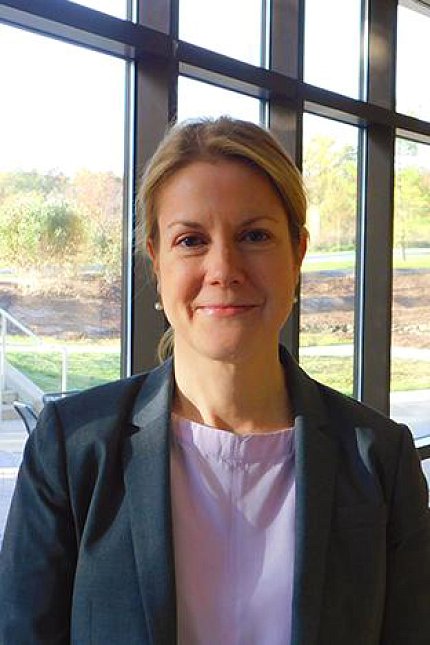Burgess Illuminates Light’s Role in Health

Many of us have been spending more time inside during the Covid-19 public health emergency, and one of the impacts is less exposure to light. In a virtual lecture titled “Lighting Up Our Lives: How Light Influences Our Physical and Mental Health,” Dr. Helen Burgess recently explored this topic. The event was part of NCCIH’s Integrative Medicine Research Lecture Series.
Burgess is professor of psychiatry and co-director of the Sleep and Circadian Research Laboratory at the University of Michigan and a grantee of NCCIH, NHLBI, NIMH and multiple other NIH components.
She focused on the most well-studied aspect of light and health: the circadian clock, an “ancient physiological system” that is largely determined by genetics. Its two parts are the central circadian clock, located in the hypothalamus, and a network of peripheral circadian clocks found in almost every cell, tissue and organ. The latter clocks have local control over many of our biological systems, such as those for behavior, hormones, inflammation and immunity. If the circadian system were an orchestra, Burgess said, the central clock is the conductor and the peripheral clocks are the instruments.
In about 70 percent of us, the central clock takes a little more than 24 hours to complete one cycle. This creates a tendency over time to “phase delay” (i.e., move the circadian clock later). How can affected people get and stay in sync with an environment running on a 24-hour clock? Researchers are exploring strategies to “phase advance,” including by manipulating the properties of light and exposure to it. Lifestyle measures may also help.
Since the 1980s, light therapy has been a mainstay of treating seasonal affective disorder (SAD), a type of depression that usually starts in late fall and early winter (because of less sunlight) and often eases in the longer days of spring and summer. Currently, an exciting avenue of research is extending investigation of light’s effects on health to diseases and conditions beyond SAD.
“The circadian system profoundly affects our health, and it’s one of the fundamental pillars of health, along with sleep, diet and exercise,” Burgess said, “We now know that more than 50 percent of genes express themselves with a circadian rhythm…It’s most fascinating to me that when we are exposed to light, our physiological response will be completely different depending on the time of day we receive it, in relation to our internal circadian clock.” In addition, light sensitivity and how one responds to light vary between individuals.
Burgess offered some suggestions on how viewers could leverage their light exposure to benefit health. For example, “for those of us who need to shift earlier (i.e., phase advance), morning light is the most important light we receive during the day. In contrast, evening light, light before bed and light during your sleep episode will shift you later.

“For many of us, evening light is not our friend,” she continued. “But we know there’s a lot of light pollution at night, and as human beings we tend to engage in behaviors that are not always the best for us. Ninety percent of Americans use a light-emitting technology device in the hour before bedtime, according to one survey. So does it really matter whether our clock and sleep times shift a bit?”
The answer is yes, over time. The term “social jet lag,” coined by Dr. Till Roenneberg at Ludwig Maximilian University in Munich, Germany, describes a syndrome similar to normal jet lag but arising from lack of alignment between a person’s biological and social clocks.
“Making subtle but chronic shifts of 2 hours or more in your circadian timing may have long-term health consequences,” Burgess cautioned.
So far, cross-sectional studies have found links to higher risk for depression; greater likelihood for alcohol and caffeine use and smoking; higher body mass index; and negative changes in some common measures such as resting heart rate, C-reactive protein, high-density lipoprotein cholesterol and trigylcerides. This situation might reflect some self-medication for difficult symptoms of social jet lag. Results of longitudinal studies are pending.
Light also has physiological effects beyond its effect on circadian timing. For example, light suppresses melatonin. In many studies, lower levels of melatonin secretion overnight were predictive of development of breast cancer, hypertension, insulin resistance or type 2 diabetes in participants. An emerging literature suggests that giving people supplemental melatonin might help suppress systemic inflammatory markers, but this area needs further investigation.
Light may also affect neurotransmitters in the brain. A study conducted by Dr. Lily Yan at Michigan State University found light-dependent increases in serotonin (a chemical important in mood) in many different brain areas of a day-active rodent model.
With respect to chronic pain, one of the speaker’s studies was a small, NCCIH-funded pilot project conducted in women with fibromyalgia. Participants received one hour of bright light treatment either in the morning or evening from a light box. The researchers examined outcomes related to function, pain sensitivity and circadian timing. They found improvements in function and pain sensitivity from both morning and evening light treatments. But those improvements became clinically meaningful only from morning light, also the only light treatment to improve pain tolerance (phase-advancing was offered as a possible mechanism).
A second NCCIH-supported study, in military veterans with chronic low-back pain, found morning light treatment was helpful in reducing pain and suggested possible benefits for post-traumatic stress disorder. Light treatment, Burgess said, is relatively easy to access compared to many other interventions and requires less physical exertion for pain patients. It should also be studied in treatment combinations.
To promote wellness, Burgess suggested the following:
- Try to get more light during the day—outdoors if possible, with 30 minutes to an hour as a typical amount. “Morning light is good for most of us,” she said. However, two groups should first consult their health care providers: older adults (because their circadian rhythms normally shift earlier in aging) and people with bipolar disorder (as extra light might be overly stimulating).
- Usually, being outside offers brighter light than being inside (although not always). For most people, going outside for light as soon as possible after waking up is the best time—but if the morning is too busy, one can go out sometime before sunset (weather permitting, of course).
- Exposure to ultraviolet light carries risks to the eyes. You might choose to go without sunglasses for just part of your time outdoors or wear sunglasses the entire time, in which case you will still receive some benefits from light.
- When inside, try to sit by a window, if possible.
- After sunset, minimize your exposure to artificial light. Use distance and dimming—e.g., watching a TV across the room is better than using a cell phone or tablet close to your eyes. The more you dim your evening light, the less you will phase delay (have your circadian cycle move later).
- Don’t use light-emitting devices in the hour before you go to bed.
- Set an alarm for a half hour before you usually go to bed. Retiring at the earlier time will help in obtaining the 7 to 8 hours (at least) of sleep recommended by the American Academy of Sleep Medicine.
- Don’t treat yourself with melatonin without talking to your health care provider first. Underlying medical conditions and potential drug interactions are among the factors to consider.
- People who cannot get outside and don’t have the benefit of a window sometimes consider light boxes. These are available and often less expensive than wearable light devices. If you have an eye disease, talk to your ophthalmologist first before considering a light device, and if you have a mental health diagnosis, especially bipolar disorder, talk to your mental health professional first.
The full lecture is available at https://videocast.nih.gov/watch=37830.
